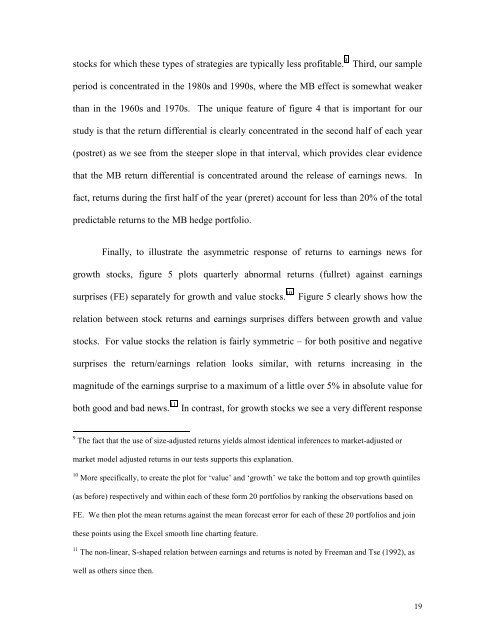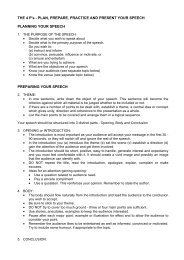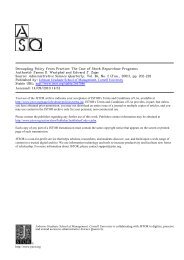Earnings Surprises, Growth Expectations, and Stock Returns:
Earnings Surprises, Growth Expectations, and Stock Returns:
Earnings Surprises, Growth Expectations, and Stock Returns:
You also want an ePaper? Increase the reach of your titles
YUMPU automatically turns print PDFs into web optimized ePapers that Google loves.
stocks for which these types of strategies are typically less profitable. 9 Third, our sample<br />
period is concentrated in the 1980s <strong>and</strong> 1990s, where the MB effect is somewhat weaker<br />
than in the 1960s <strong>and</strong> 1970s. The unique feature of figure 4 that is important for our<br />
study is that the return differential is clearly concentrated in the second half of each year<br />
(postret) as we see from the steeper slope in that interval, which provides clear evidence<br />
that the MB return differential is concentrated around the release of earnings news. In<br />
fact, returns during the first half of the year (preret) account for less than 20% of the total<br />
predictable returns to the MB hedge portfolio.<br />
Finally, to illustrate the asymmetric response of returns to earnings news for<br />
growth stocks, figure 5 plots quarterly abnormal returns (fullret) against earnings<br />
surprises (FE) separately for growth <strong>and</strong> value stocks. 10 Figure 5 clearly shows how the<br />
relation between stock returns <strong>and</strong> earnings surprises differs between growth <strong>and</strong> value<br />
stocks. For value stocks the relation is fairly symmetric – for both positive <strong>and</strong> negative<br />
surprises the return/earnings relation looks similar, with returns increasing in the<br />
magnitude of the earnings surprise to a maximum of a little over 5% in absolute value for<br />
both good <strong>and</strong> bad news. 11 In contrast, for growth stocks we see a very different response<br />
9 The fact that the use of size-adjusted returns yields almost identical inferences to market-adjusted or<br />
market model adjusted returns in our tests supports this explanation.<br />
10 More specifically, to create the plot for ‘value’ <strong>and</strong> ‘growth’ we take the bottom <strong>and</strong> top growth quintiles<br />
(as before) respectively <strong>and</strong> within each of these form 20 portfolios by ranking the observations based on<br />
FE. We then plot the mean returns against the mean forecast error for each of these 20 portfolios <strong>and</strong> join<br />
these points using the Excel smooth line charting feature.<br />
11 The non-linear, S-shaped relation between earnings <strong>and</strong> returns is noted by Freeman <strong>and</strong> Tse (1992), as<br />
well as others since then.<br />
19







